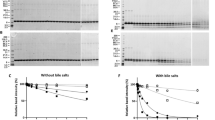Abstract
Pen a 1 is a major shrimp allergen that induces an allergy. The aim of this study is to assess the effect of simulated gastrointestinal fluids on the allergenicity of Pen a 1. Purified Pen a 1 from shrimp (Penaeus vannamei) was subjected to digestion in SGF (simulated gastric fluid) and SIF (simulated intestinal fluid) for a set time. The allergenicity of digestive Pen a 1 was analyzed by immunoblotting and Ci-ELISA, using pool sera from patients with shrimp specific IgE. The results showed that Pen a 1 exhibited a decrease in allergenicity with increasing digestion time in the SGF and SIF. However, Pen a l exhibited strong resistance to digestive fluids, and all yielded fragments (33 kD, 23 kD, and 14 kD) showed allergic activity. Therefore, anti-digestion may be an important factor for Pen a 1 to induce an allergy.
Similar content being viewed by others
References
Asturias J A, Nuria G B, Carmen A M, Alberto M. 1999. Molecular characterization of American cockroach tropomyosin (Periplaneta americana Allergen 7), a cross-reactive allergen. J. Immunol., 162: 4 342–4 348.
Bailey K. 1946. Tropomyosin: a new asymmetric protein component of muscle. Nature, 157: 368–369.
Bannon G A. 2004. What makes a food protein an allergen? Curr. Allergy. Asthma. Rep., 4: 43–46.
Daul C B, Morgan J E, Lehrer S B. 1993. Hypersensitivity reactions to crustacea and mollusks. Clin. Rev. Allergy, 11(2): 201–222.
Daul C B, Morgan J E, Lehrer S B. 1990. The natural history of shrimp hypersensitivity. J. Allergy. Clin. Immunol., 86(1): 88–93.
Daul C B, Stattery M, Reese G, Lehrer S B. 1994. Identification of the major brown shrimp (Penaeus aztecus) allergen as the muscle protein tropomyosin. Int. Arch. Allergy. Immunol., 105: 49–55.
FAO/WHO. 2001. Evaluation of allergenicity of genetically modified food; Report of a joint FAO/WHO expert consultation on allergenicity of foods derived from biotechnology; Food and Agriculture Organization of the United Nations (FAO): Rome, Italy.
Fu T J, Abbott U R, Hatzos C. 2002. Digestibility of food allergens and nonallergenic proteins in simulated gastric fluid and simulated intestinal fluid-A comparative study. J. Agric. Food Chem., 50: 7 154–7 160.
Hefle S L. 1996. The chemistry and biology of food allergens. Food Technol., 50: 86–92.
Hoffman D R, Day E D Jr, Miller J S. 1981. The major heat stable allergen of shrimp. Ann. Allergy., 47: 17–22.
Huby R D, Dearman R J, Kimber I. 2000. Why are some proteins allergens? Toxicol. Sci., 55: 235–246.
Laemmli U K. 1970. Cleavage of structural proteins during the assembly of the head of bacteriophage T4. Nature, 227: 680–685.
Lehrer S B, Horner E, Reese G. 1996. Why are some proteins allergenic? Implications for biotechnology. Crit. Rev. Food Sci. Nutr., 36: 553–564.
Leung P S, Chu K H, Chow W K, Ansari A, Bandea C I, Kwan H S, Nagy S M, Gershwin M E. 1994. Cloning, expression, and primary structure of Metapenaeus ensis tropomyosin, the major heat-stable shrimp allergen. J. Allergy Clin. Immuno., l94: 880–890.
Matthias B, Hans S, Angelika P. 2001. Stability of food allergens and allergenicity of processed foods. J. Chromatogr B: Biomed. Sci. Appl., 756(1–2): 207–228.
Metcalfe D D, Astwood J D, Townsend R, Sampson H S, Taylor S L, Fuchs R L. 1996. Assessment of the allergenic potential of foods derived from genetically engineered crop plants. Crit. Rev. Food Sci. Nutr., 36: S165–86.
Metcalfe D D, Astwood J D. Townsend R, Sampson H S, Taylor S L, Fuchs R L. 1996. Assessment of the allergenic potential of foods derived from genetically engineered crop plants. Crit. Rev. Food Sci. Nutr., 36: S165–86.
Mills E N C, Madsen C, Shewry P R, Wichers H J. 2003. Food allergens of plant origin-their molecular and evolutionary relationships. Trends Food Sci. Technol., 14: 145–156.
Rockville M D. 1995. Simulated gastrointestinal fluid. In: The United States pharmacopeia 23, The National Formulary 18. Rockville, MD: United States Pharmacopeial Convention, Inc. p. 2053.
Smillie L B. 1982. Preparation and identification of α and β tropomyosins. Methods in Enzymology, 85: 234–241.
Smith I, Cromie R, Stainsby K. 1988. Seeing gel wells well. Analytical Biochemistry, 169: 370–371.
Taylor S L, Hefle S L. 2001. Will genetically modified foods be allergenic? Curr. Rev. Allergy Clin. Immunol., 107: 765–771.
Taylor S L, Lehrer S B. 1996. Principles and characteristics of food allergens. Crit. Rev. Food Sci. Nutr., 36: S91–118.
Thomas K, Aalbers M, Bannon G A, Bartels M, Dearman R J, Esdaile D J. 2004. A multi-laboratory evaluation of a common in vitro pepsin digestion assay protocol used in assessing the safety of novel proteins. Regul. Toxicol. Pharmacol., 39: 87–98.
Towbin H, Gordon J. 1984. Immunoblotting and dot blotting: current status and outlook. The Journal of Immunology, 72: 313–340.
Yu C J. 2003. Proteomics and immunological analysis of a novel shrimp allergen, Pen m 2. The Journal of Immunology, 170: 445–453.
Author information
Authors and Affiliations
Corresponding author
Additional information
Supported by the National High Technology Research and Development Program of China (863 Program) (NO.2006AA09Z427) and the National Natural Science Foundation of China (Nos. 30800859, 30871948)
Rights and permissions
About this article
Cite this article
Guo, Y., Li, Z. & Lin, H. The effect of simulated gastrointestinal digestion on shrimp Penaeus vannamei allergenicity. Chin. J. Ocean. Limnol. 27, 703–707 (2009). https://doi.org/10.1007/s00343-009-9190-3
Received:
Accepted:
Published:
Issue Date:
DOI: https://doi.org/10.1007/s00343-009-9190-3




